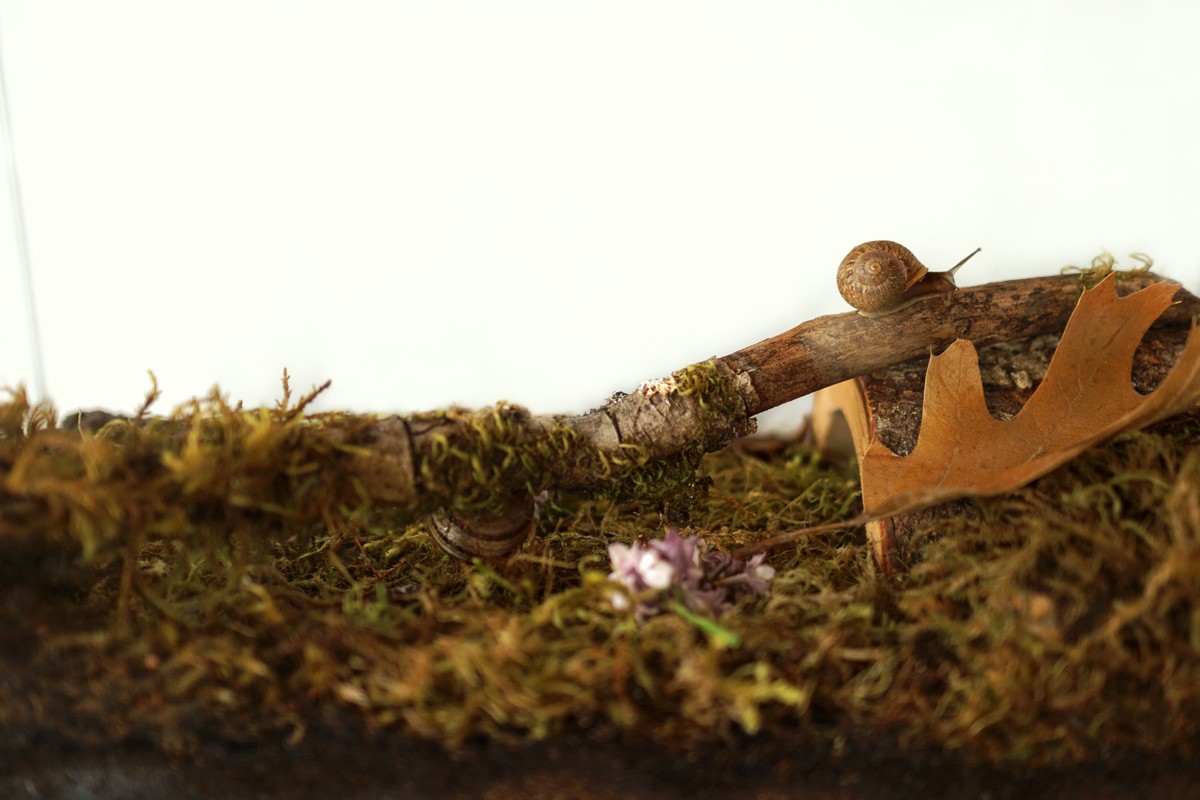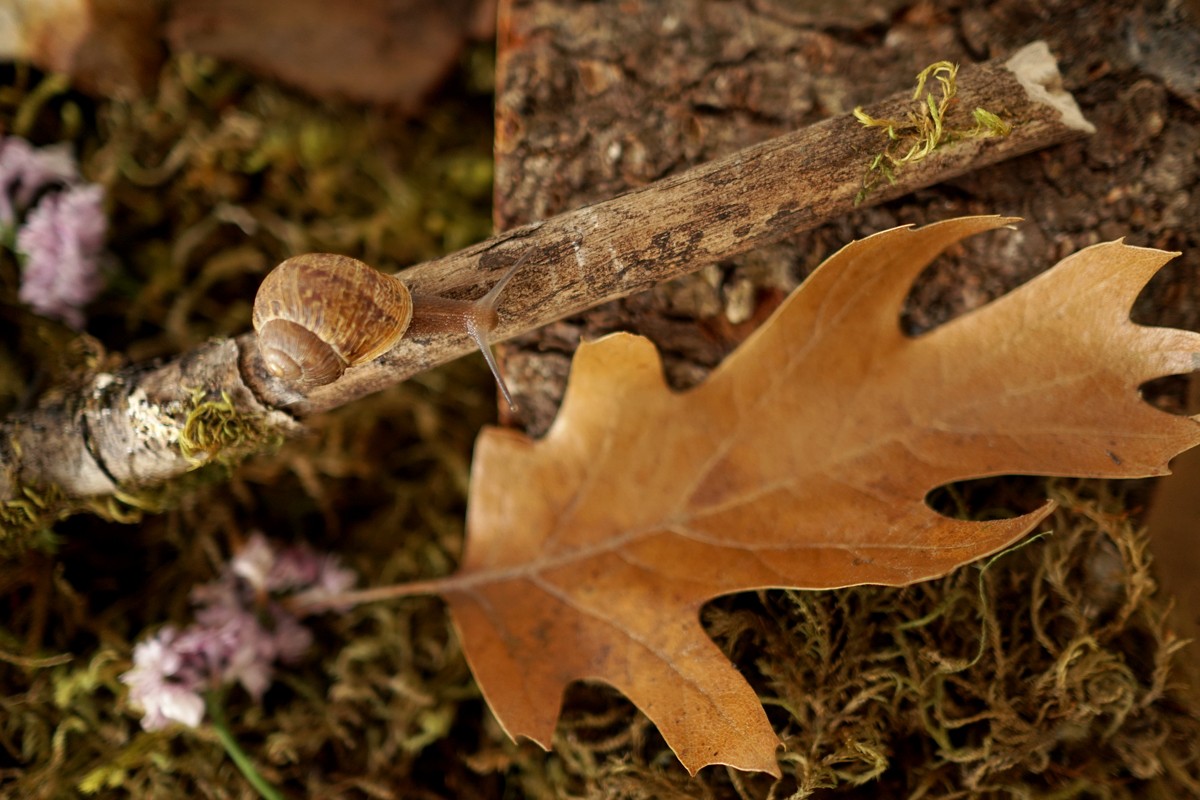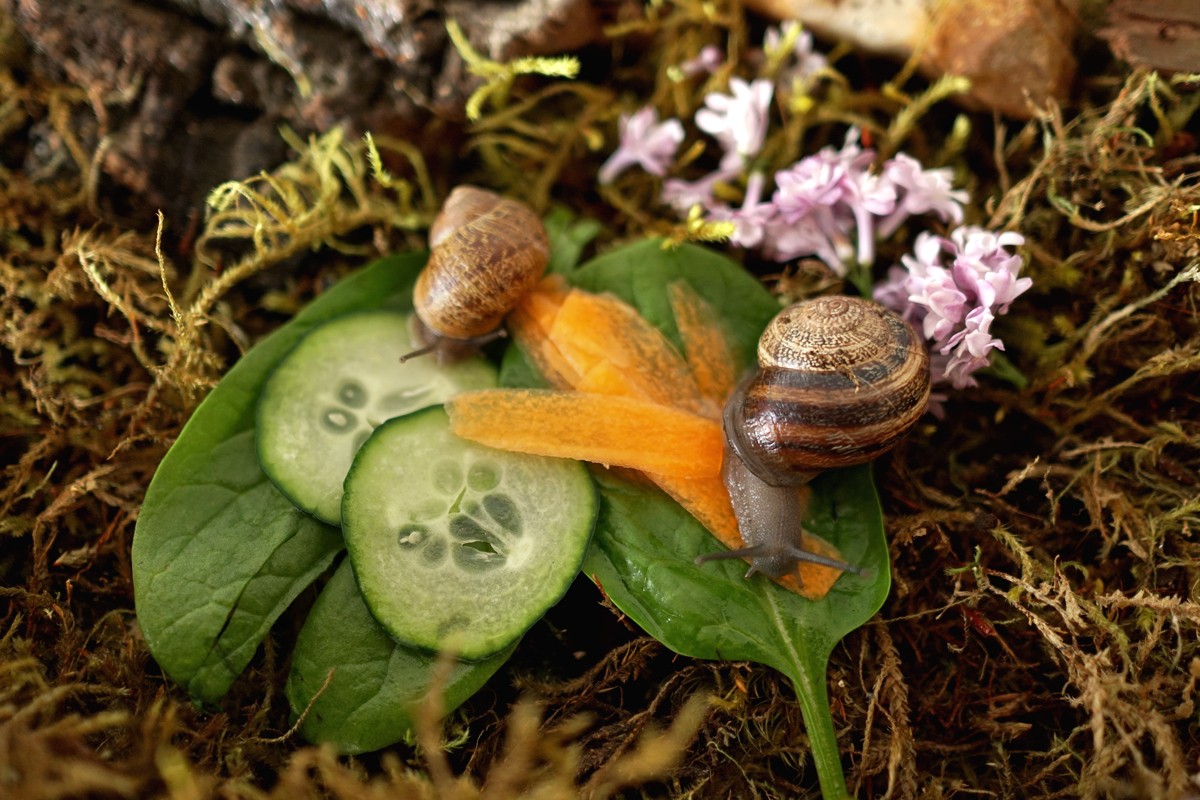Are you wondering, “Can I Keep A Snail As A Pet?” PETS.EDU.VN provides a comprehensive guide to snail ownership, covering everything from habitat setup to daily care, ensuring a delightful and educational experience. Explore the fascinating world of snail keeping and discover why these low-maintenance creatures make wonderful pets, and learn how to create a thriving environment for your new shelled companions, including proper diet, tank maintenance, and health considerations. Let’s delve into the joy of keeping gastropods as pets.
1. Understanding the Allure of Snail Keeping
Snails, often overlooked, are emerging as fascinating and low-maintenance pets. Their gentle nature and quiet demeanor make them ideal companions for individuals seeking a calming and educational pet-keeping experience. Before embarking on this unique journey, it’s essential to understand their basic needs, behavior, and the commitment involved.
1.1. Why Choose a Snail as a Pet?
Snails offer several unique benefits as pets:
- Low Maintenance: Snails require minimal care compared to other pets, making them suitable for busy individuals or those new to pet ownership.
- Educational Value: Observing snail behavior, feeding habits, and life cycle can be highly educational, especially for children.
- Space-Saving: Snails thrive in relatively small terrariums, making them ideal for apartments or homes with limited space.
- Quiet Companions: Unlike many pets, snails are silent, providing a peaceful and relaxing environment.
- Unique Observation: Their slow movements and interesting eating habits are enjoyable to watch.
1.2. Different Types of Pet Snails
Several snail species are well-suited for captivity. Each has unique characteristics and care requirements:
- Garden Snail (Cornu aspersum): The most common pet snail, adaptable and easy to care for.
- Giant African Land Snail (Achatina fulica): Known for its large size and distinctive appearance. Requires more space and specific humidity levels.
- Milk Snail (Otala lactea): A smaller species that prefers drier conditions, native to the Mediterranean.
- Grove Snail (Cepaea nemoralis): Known for its colorful shell variations.
1.3. Snail Lifespan
Snails typically live for 1-5 years, depending on the species and care they receive. Some Giant African Land Snails have been known to live for up to 7 years in captivity. Providing proper care, including a balanced diet, appropriate humidity, and a clean environment, can significantly extend their lifespan.
2. Setting Up Your Snail’s Habitat
Creating the right habitat is crucial for the health and happiness of your pet snail. A well-designed terrarium mimics their natural environment and provides everything they need to thrive.
2.1. Choosing the Right Terrarium
The size of your terrarium depends on the number of snails you plan to keep. A good rule of thumb is:
| Number of Snails | Minimum Terrarium Size |
|---|---|
| 1-2 | 5 gallons |
| 3-5 | 10 gallons |
| 6-10 | 20 gallons |




- Material: Glass or plastic terrariums are suitable. Glass provides better visibility, while plastic is lighter and more durable.
- Ventilation: Ensure the terrarium has adequate ventilation to prevent mold and maintain air quality. A mesh lid is ideal.
- Lid: A tight-fitting lid is essential to prevent snails from escaping. Snails are surprisingly adept at climbing and can squeeze through small openings.
2.2. Substrate Selection: Recreating Nature
The substrate is the material that lines the bottom of the terrarium. It provides a place for snails to burrow, retain moisture, and helps maintain humidity.
- Coconut Coir: A popular choice for its excellent moisture retention and natural properties.
- Peat Moss: Retains moisture well but can be acidic. Ensure it’s pH-neutralized before use.
- Sterilized Soil: Use soil specifically designed for terrariums to avoid harmful chemicals or parasites.
- Avoid: Sand, gravel, and potting soil with fertilizers or pesticides.
2.3. Furnishing the Terrarium
Adding decorations to the terrarium provides enrichment and hiding places for your snails.
- Hiding Spots: Provide caves, logs, or overturned flower pots for snails to retreat and feel secure.
- Climbing Structures: Add branches, cork bark, or plastic plants for snails to climb on.
- Live Plants: Introduce live plants like ferns, mosses, or edible greens. Ensure they are safe for snails to consume.
2.4. Maintaining Humidity and Temperature
Snails require a humid environment to thrive. The ideal humidity level varies depending on the species:
- Garden Snails: 70-80% humidity
- Giant African Land Snails: 80-90% humidity
To maintain humidity:
- Misting: Mist the terrarium daily with filtered water using a spray bottle.
- Water Dish: Provide a shallow dish of water for snails to drink and bathe in.
- Substrate Moisture: Keep the substrate consistently damp, but not waterlogged.
Temperature:
Snails generally prefer temperatures between 65-75°F (18-24°C). Avoid placing the terrarium in direct sunlight or near heat sources.
3. Snail Diet and Nutrition
A balanced diet is essential for the health and growth of your pet snail. Snails are herbivores and require a variety of fresh fruits, vegetables, and a calcium source.
3.1. What to Feed Your Snail
- Leafy Greens: Lettuce, kale, spinach, and collard greens are excellent choices.
- Vegetables: Carrots, cucumbers, zucchini, and sweet potatoes provide essential vitamins and minerals.
- Fruits: Apples, bananas, strawberries, and melons can be offered in moderation. Avoid citrus fruits, as they are too acidic.
- Calcium Source: Cuttlebone, crushed eggshells, or calcium carbonate powder are essential for shell growth and maintenance.
3.2. Feeding Schedule and Portion Sizes
- Daily Feeding: Offer fresh food daily, removing any uneaten portions to prevent mold growth.
- Portion Size: Provide enough food for the snails to consume within 24 hours. Adjust the amount based on their appetite and the number of snails in the terrarium.
3.3. Foods to Avoid
- Salty Foods: Salt is toxic to snails. Avoid any foods containing salt.
- Processed Foods: Avoid processed foods, as they often contain harmful additives.
- Citrus Fruits: Citrus fruits like oranges, lemons, and grapefruits are too acidic and can harm snails.
- Grains and Bread: Snails have difficulty digesting grains and bread.
- Avocado: This is toxic for snails.
4. Handling and Interacting with Your Pet Snail
Handling snails requires gentle care to avoid harming them. With proper handling, snails can become accustomed to human interaction.
4.1. Safe Handling Techniques
- Wash Your Hands: Always wash your hands thoroughly before and after handling snails to prevent the spread of bacteria.
- Gentle Touch: Handle snails gently and avoid squeezing or dropping them.
- Moist Hands: Moisten your hands with water before handling snails to prevent their skin from drying out.
- Support the Shell: When picking up a snail, gently support its shell to avoid causing stress or injury.
4.2. Recognizing Snail Behavior
Understanding snail behavior can help you better care for your pet.
- Activity: Snails are most active during the night and early morning.
- Burrowing: Snails burrow into the substrate to rest or seek moisture.
- Climbing: Snails enjoy climbing on objects in their terrarium.
- Eating: Snails use their rasp-like tongue (radula) to scrape food.
4.3. Potential Risks
- Salmonella: Snails can carry Salmonella bacteria, so it’s essential to wash your hands after handling them.
- Parasites: Wild-caught snails may carry parasites. Quarantine new snails before introducing them to your existing terrarium.
5. Maintaining a Healthy Snail Environment
Regular maintenance is essential to keep your snail’s habitat clean and healthy.
5.1. Cleaning the Terrarium
- Daily Spot Cleaning: Remove uneaten food, waste, and dead plant matter daily.
- Monthly Deep Cleaning: Once a month, remove all substrate, decorations, and plants. Clean the terrarium with warm, soapy water (ensure the soap is non-toxic and rinse thoroughly). Replace the substrate and return the decorations and plants.
5.2. Monitoring Humidity and Temperature
- Humidity: Use a hygrometer to monitor humidity levels and adjust misting as needed.
- Temperature: Use a thermometer to monitor temperature and ensure it remains within the ideal range.
5.3. Preventing and Treating Common Snail Ailments
- Shell Problems: Cracks or thin shells can be caused by a calcium deficiency. Ensure your snail has a constant source of calcium.
- Parasites: Quarantine new snails and monitor them for signs of parasites. Consult a veterinarian or experienced snail keeper for treatment options.
- Fungal Infections: Maintain proper ventilation and avoid overwatering to prevent fungal infections.
6. Ethical Snail Keeping
Keeping snails as pets comes with ethical responsibilities. It’s important to ensure their welfare and provide them with the best possible care.
6.1. Responsible Sourcing
- Avoid taking snails from the wild. Wild populations can be fragile, and removing snails can disrupt the ecosystem.
- Purchase snails from reputable breeders or pet stores that prioritize the health and welfare of their animals.
- Ensure the snails you acquire are legally obtained and not subject to any restrictions or regulations.
6.2. Providing Enrichment
- Snails need mental stimulation to prevent boredom and promote natural behaviors.
- Regularly rearrange the terrarium, adding new objects and hiding places.
- Offer a variety of food items to keep their diet interesting.
- Consider adding compatible tankmates, such as isopods or springtails, to create a more dynamic ecosystem.
6.3. Preventing Escapes
- Snails are masters of escape and can squeeze through surprisingly small openings.
- Ensure the terrarium has a secure lid that fits tightly.
- Regularly inspect the enclosure for any potential escape routes and seal them off.
- If a snail does escape, search for it in damp, dark places.
6.4. Understanding Local Regulations
- Some areas have regulations regarding the keeping of certain snail species.
- Check with your local authorities to ensure you are complying with all applicable laws.
- Be aware of any restrictions on the release of snails into the wild, as this can have negative consequences for native ecosystems.
7. The Joys of Observing Snails
One of the greatest pleasures of keeping snails as pets is observing their unique behaviors and interactions.
7.1. Snail Social Behavior
- Snails are generally solitary creatures, but they can coexist peacefully in groups.
- Observe how snails interact with each other, such as following slime trails or touching antennae.
- Some snail species may exhibit courtship behaviors, such as shell rubbing or dancing.
7.2. Snail Feeding Habits
- Watching snails eat is a fascinating experience.
- Observe how they use their radula to scrape food and the patterns they create on leaves and vegetables.
- Some snails may exhibit preferences for certain food items over others.
7.3. Snail Reproduction
- Snails are hermaphrodites, meaning they have both male and female reproductive organs.
- Observe the mating process, which can involve intricate rituals and the exchange of sperm packets.
- If you choose to breed snails, be prepared to care for the offspring and find suitable homes for them.
8. Advanced Snail Keeping Techniques
For experienced snail keepers, several advanced techniques can enhance the well-being and enjoyment of your pet snails.
8.1. Creating a Bioactive Terrarium
A bioactive terrarium is a self-sustaining ecosystem that includes live plants, beneficial microorganisms, and invertebrates like springtails and isopods.
- Benefits: Reduces the need for frequent cleaning, provides a more natural environment, and offers additional enrichment for your snails.
- Setup: Create a drainage layer, add a layer of substrate, introduce live plants and invertebrates, and allow the ecosystem to establish before adding your snails.
8.2. Breeding Snails
Breeding snails can be a rewarding experience, but it requires careful planning and preparation.
- Requirements: Provide a suitable breeding environment, maintain optimal humidity and temperature, and offer a nutritious diet.
- Egg Care: Collect eggs and incubate them in a separate container with moist substrate.
- Hatchling Care: Provide hatchlings with a shallow dish of water, soft food, and a constant source of calcium.
8.3. Building a Paludarium
A paludarium combines terrestrial and aquatic elements, creating a diverse and visually stunning habitat.
- Design: Incorporate a water feature, such as a pond or waterfall, and a land area with plants and decorations.
- Compatibility: Choose snail species that are compatible with aquatic environments.
9. Finding Information and Services
Reliable information and quality services are essential for responsible pet ownership.
9.1. Vetenarians
If your snail exhibits signs of illness or injury, consult a veterinarian experienced in treating invertebrates.
9.2. Online Communities
Connect with other snail enthusiasts through online forums, social media groups, and websites dedicated to snail keeping.
9.3. Local Pet Stores
Support local pet stores that carry snail supplies and offer expert advice.
PETS.EDU.VN offers a wide range of resources and services to help you care for your pet snails.
- Informative articles and guides on snail care, feeding, and health.
- A directory of veterinarians and pet stores specializing in snail care.
- A community forum where you can connect with other snail keepers and ask questions.
- Products to enhance your snail’s terrarium: Substrates, plants, and decorations.
10. Frequently Asked Questions (FAQ) About Keeping Snails as Pets
- Are snails good pets for children? Yes, snails can be great pets for children, teaching them responsibility and respect for living creatures. However, adult supervision is essential to ensure safe handling and prevent the spread of bacteria.
- Do snails need a lot of attention? No, snails are low-maintenance pets and do not require a lot of attention. Regular feeding, cleaning, and misting are usually sufficient.
- Can snails recognize their owners? Snails do not have the cognitive ability to recognize their owners in the same way as dogs or cats. However, they may become accustomed to being handled and associate it with positive experiences.
- Do snails smell? No, snails do not have a strong odor. However, a poorly maintained terrarium can develop an unpleasant smell. Regular cleaning is essential to prevent odors.
- How do I know if my snail is sick? Signs of illness in snails include lethargy, loss of appetite, shell problems, and unusual behavior. If you notice any of these symptoms, consult a veterinarian or experienced snail keeper.
- Can I keep different species of snails together? It is generally not recommended to keep different species of snails together, as they may have different care requirements and could potentially transmit diseases.
- How do I handle snail eggs? If you find snail eggs in your terrarium, you can either leave them to hatch or remove them to prevent overpopulation. If you choose to incubate the eggs, place them in a separate container with moist substrate.
- What is the best substrate for snails? Coconut coir is one of the best substrates for snails, as it retains moisture well and is free of harmful chemicals.
- Can snails eat dog or cat food? No, snails should not eat dog or cat food, as it contains ingredients that are harmful to them.
- Where can I get a pet snail? You can buy pet snails from reputable breeders or pet stores. Avoid taking snails from the wild, as this can harm wild populations.
Embarking on the journey of snail keeping can be incredibly rewarding. By understanding their needs, providing a suitable environment, and offering proper care, you can enjoy the unique companionship of these fascinating creatures. Visit PETS.EDU.VN for more in-depth guides, expert advice, and resources to enhance your snail-keeping experience. For further assistance, contact us at 789 Paw Lane, Petville, CA 91234, United States, Whatsapp: +1 555-987-6543, or visit our website at pets.edu.vn.